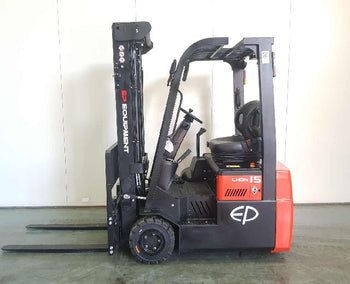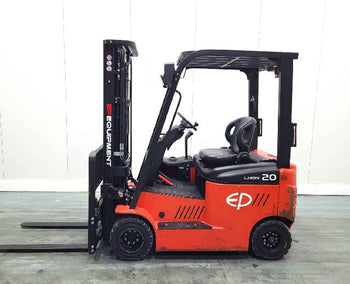Choosing between electric and diesel forklifts is more than a question of price. The power source you select influences operating costs, maintenance needs, workplace emissions and the longevity of your investment. Diesel trucks have historically been the go‑to option for rugged outdoor work, but modern battery technology, rising fuel prices and corporate sustainability goals mean electric forklifts are now a compelling alternative. This guide compares the two technologies from a UK perspective, using current market pricing and energy costs to help you decide which is best for your business.
Upfront Cost and Total Cost of Ownership
Purchase price. Forklift prices vary widely by capacity and specification. A general UK guide notes that a basic forklift costs £9,000–£22,000, while specialised or high‑capacity machines can exceed £35,000–£75,000. Electric counterbalance forklifts generally fall in the £10,000–£30,000 range for new models, with high‑capacity variants reaching beyond £40,000. Used electric trucks often cost £5,000–£20,000. Diesel forklifts, by contrast, typically sell for £11,000–£20,000. These figures reflect base specifications; optional attachments and specialised equipment will increase the cost.
Energy and fuel costs. Purchase price tells only part of the story; what a machine costs to operate each hour often dwarfs the initial outlay over the life of the truck. UK business electricity currently costs about 22.36 p/kWh. An electric forklift drawing roughly 5 kWh per hour therefore costs about £1.10 per hour in electricity. Diesel fuel averages 142 p per litre, and a diesel forklift burns 2–3 litres per hour, leading to an hourly fuel bill of £2.8–£4.3. Electric forklifts are therefore typically £1.5–£3 per hour cheaper to run than equivalent diesel models. Over an eight‑year service life this difference can easily offset the higher purchase price of an electric lift and, in many cases, delivers payback within two years.
Maintenance and lifecycle costs. Electric motors have far fewer moving parts than internal‑combustion engines. Because there are no spark plugs, injectors or exhaust systems, service intervals are longer—often 1,000 hours between major services—and annual maintenance can be as low as £800–£2,000. Diesel forklifts require oil and filter changes, belt replacements and tune‑ups every 500–1,000 hours. With more fluids and components to manage, annual maintenance typically runs £1,200–£3,200, and unplanned downtime is more likely. When added to higher fuel expenditure, diesel’s operating costs quickly exceed its lower purchase price.

Operating Efficiency and Productivity
Energy efficiency. Electric forklifts convert a greater share of input energy into motion. They deliver instant torque without idling losses, and regenerative braking recovers energy during deceleration. Diesel engines waste fuel when idling and must maintain a minimum speed to avoid stalling. Even modern diesel designs with improved hydraulics and fuel injection cannot match the overall energy efficiency of electric drives. For businesses running multi‑shift operations, the cumulative fuel saving can be substantial.
Runtime and refuelling. Historically, electric forklifts were criticised for limited runtime and long charging times. A standard battery provides about six to eight hours of operation; however, lithium‑ion technology has reduced charging times and allows for opportunity charging during breaks. Many modern lithium batteries recharge in an hour and maintain consistent performance across their discharge cycle. For continuous 24‑hour operations, a spare battery or fast‑charging station may be necessary, but the lower running costs still generally justify the investment.
Diesel forklifts excel in runtime. As long as there is fuel in the tank they will run continuously, and refuelling takes minutes. This makes them well suited to remote locations or applications where shifts are long and refuelling infrastructure already exists. However, every refuel incurs a cost, and idling during breaks burns fuel unnecessarily.
Performance and Application Suitability
Power and load capacity. Diesel engines deliver high torque and horsepower, making diesel forklifts ideal for handling heavy loads, steep inclines and rough terrain. They maintain lifting capacity throughout the shift and are less affected by wet or dusty conditions. Electric forklifts have improved dramatically, and high‑capacity models now approach the load ratings of their diesel counterparts. Electric motors provide instant torque and smooth acceleration, allowing operators to manoeuvre precisely in tight aisles. They are typically more compact, so they have a tighter turning radius and improved visibility, which can boost productivity in warehouse environments.
Indoor vs outdoor use. Electric forklifts produce zero tailpipe emissions and operate at 60–70 decibels. They are therefore the standard in warehouses, cold storage, food processing and other indoor settings where air quality and noise levels matter. Their quiet operation improves communication on the shop floor and reduces operator fatigue. Diesel forklifts are better suited to outdoor environments such as construction sites, lumber yards and ports. They tolerate uneven ground, wind and rain, and their refuelling flexibility makes them practical where charging infrastructure is absent. However, they emit exhaust gases and soot and often exceed acceptable noise limits for indoor use.

Environmental Impact
Environmental considerations are increasingly part of capital‑equipment decisions. Electric forklifts have clear advantages: they produce no exhaust fumes at the point of use and therefore improve indoor air quality. While emissions are associated with electricity generation and battery production, they are much lower than those from burning diesel. Producing and burning diesel fuel releases several kilograms of carbon dioxide for every hour of operation, whereas an electric forklift powered by the UK grid emits roughly 1.4 kg CO₂ per hour. Over a typical service life, each electric truck can eliminate tens of tonnes of CO₂ compared with a combustion‑engine counterpart.
Diesel equipment also emits nitrogen oxides and particulates that contribute to respiratory disease. Electric trucks eliminate tailpipe gases as well as waste oil, coolant and filter disposal. These factors are increasingly important to businesses seeking to meet environmental, social and governance (ESG) targets and to appeal to sustainability‑conscious customers.
Safety and Operator Comfort
Electric forklifts eliminate the risks associated with flammable fuels and exhaust fumes. Their quieter, low‑vibration operation makes it easier for drivers to communicate and reduces fatigue. Battery handling does require proper procedures, but modern sealed batteries and training programmes minimise risks. Diesel forklifts, by contrast, involve fuel storage and produce exhaust gases that must be vented. They are louder and vibrate more, though their sealed engines can be advantageous in very wet conditions.
Key Decision Factors
Before deciding, weigh these factors:
-
Operating environment – Indoors and noise‑sensitive areas favour electric equipment, whereas rough outdoor terrain may still demand diesel power.
-
Duty cycle and load – Very heavy loads or continuous shifts can make diesel attractive for its torque and quick refuelling; medium‑duty or intermittent work suits electric models.
-
Infrastructure – Charging stations require investment but offer long‑term savings; existing fuel infrastructure may make diesel easier initially.
-
Sustainability – Electric forklifts support ESG goals and improve air quality.

Conclusion: The Business Case for Electric Forklifts
Diesel forklifts remain valuable for heavy‑duty outdoor applications and situations where continuous runtime is critical. They deliver high torque, quick refuelling and robust performance on rough terrain. However, for most indoor and light‑to‑medium‑duty tasks, electric forklifts now offer a compelling combination of lower operating costs, reduced maintenance, quieter operation and substantially smaller environmental footprints. When UK energy and fuel costs are considered, electrics can cost £1.5–£3 less per hour to run than diesel and often repay their higher purchase price within a couple of years. Their zero‑emission operation improves air quality, which protects workers and meets growing regulatory and customer expectations around sustainability. For companies seeking to future‑proof their material‑handling fleet, investing in electric forklifts is increasingly the smart choice.
To explore the electric models available and calculate potential savings for your operation, visit the Electric Forklift Hub. iLift’s specialists can provide tailored advice on selecting, financing and operating electric forklifts that match your business requirements while helping you meet your sustainability goals.





